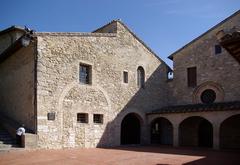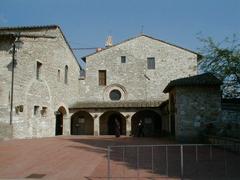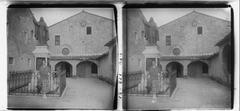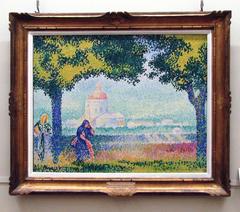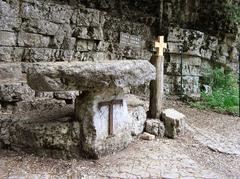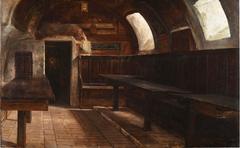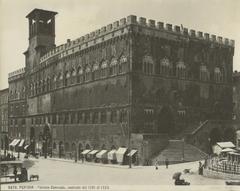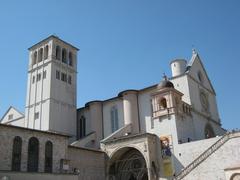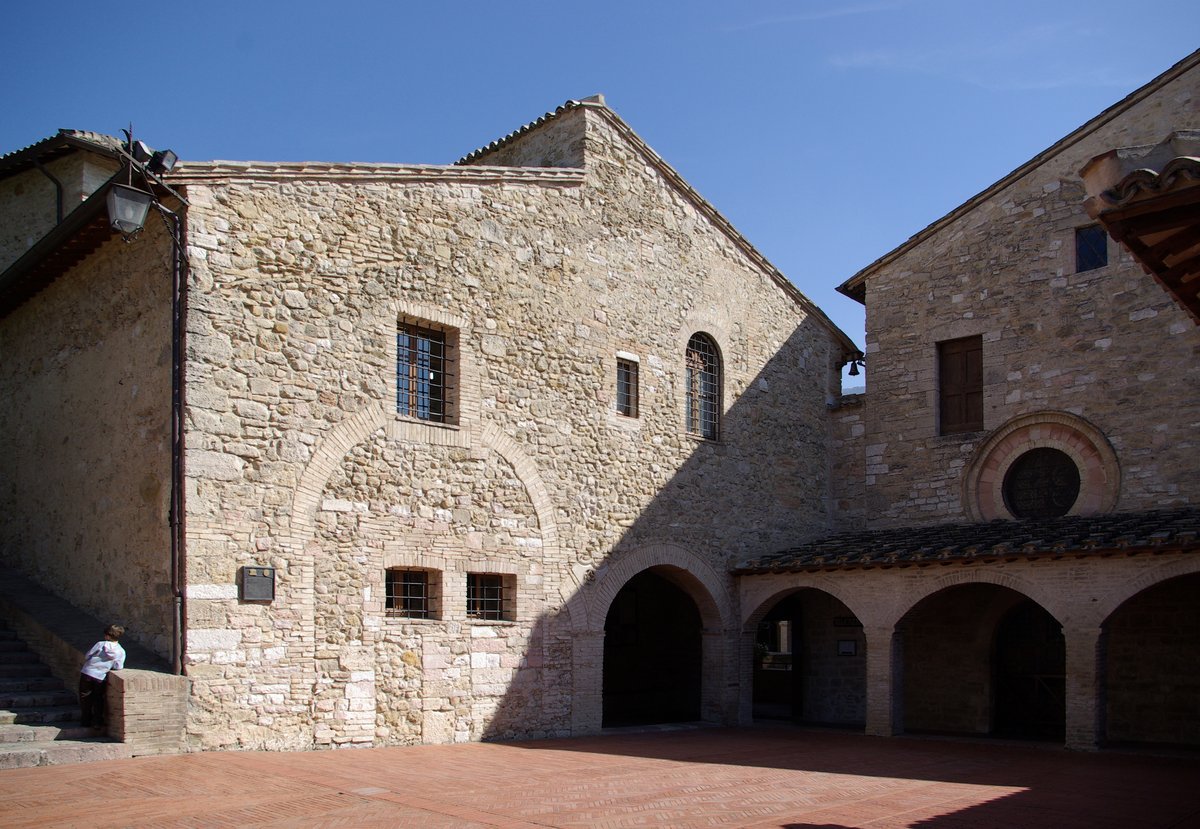
San Damiano Visiting Hours, Tickets, and Historical Sites in Assisi
Date: 16/08/2024
Introduction
San Damiano, a serene sanctuary nestled 1.5 kilometers southeast of Assisi’s historic center, is a cornerstone of spiritual and historical significance. This sanctuary, surrounded by lush olive groves, offers an atmosphere of profound tranquility and rich heritage. Its significance is rooted in pivotal moments in the lives of St. Francis of Assisi and St. Clare, who both played crucial roles in the development and spiritual prominence of this site. In 1205, St. Francis experienced a divine vision at San Damiano that led to his renunciation of worldly possessions and a life dedicated to service (Lonely Planet). Later, St. Clare established the Order of Poor Clares here, further cementing San Damiano’s status as a spiritual haven (Salt in Our Hair). This guide aims to provide comprehensive insights into the history, architectural evolution, and visitor information of San Damiano, ensuring a well-rounded understanding and enriching experience for all visitors.
Table of Contents
- Introduction
- Early Beginnings and St. Francis’ Vision
- Architectural Evolution
- The Role of St. Clare and the Poor Clares
- The Canticle of the Creatures
- The Crocifisso di San Damiano
- Pilgrimage and Spiritual Retreat
- Visitor Tips and Practical Information
- Accessibility and Nearby Attractions
- FAQ
- Conclusion
Early Beginnings and St. Francis’ Vision
San Damiano is where, in 1205, St. Francis of Assisi is said to have heard the voice of God, an event that profoundly influenced his life and mission. This divine encounter led St. Francis to renounce his worldly possessions and dedicate his life to serving the poor and rebuilding the Church. The sanctuary’s significance is further underscored by the fact that St. Francis composed his famous “Canticle of the Creatures” here, a hymn that praises God through the elements of creation (Lonely Planet).
Architectural Evolution
The original structure of San Damiano was a small, dilapidated church when St. Francis first encountered it. After his vision, he took it upon himself to restore the church. The church’s architecture reflects its humble beginnings, with simple yet profound design elements. Over the centuries, the church has undergone various renovations and expansions but has retained its original charm and spiritual ambiance. The frescoes that adorn the walls are particularly noteworthy, offering a glimpse into the artistic and religious heritage of the region (Lonely Planet).
The Role of St. Clare and the Poor Clares
San Damiano is also closely associated with St. Clare of Assisi, a follower of St. Francis and the founder of the Order of Poor Clares. After hearing St. Francis preach, Clare was inspired to join his mission and took refuge at San Damiano. She established a community of women who lived according to the Franciscan rule of poverty, humility, and simplicity. The convent at San Damiano became the first monastery of the Poor Clares, and St. Clare spent much of her life here, dedicating herself to prayer and service (Salt in Our Hair).
The Canticle of the Creatures
One of the most significant contributions of San Damiano to Christian literature and spirituality is the “Canticle of the Creatures,” composed by St. Francis. This hymn, written in the Umbrian dialect, is one of the earliest pieces of Italian literature and reflects St. Francis’ deep connection with nature. The canticle praises God through elements such as Brother Sun, Sister Moon, and Mother Earth, emphasizing the interconnectedness of all living beings (Lonely Planet).
The Crocifisso di San Damiano
Another significant artifact associated with San Damiano is the Crocifisso di San Damiano, a Byzantine-style crucifix believed to have spoken to St. Francis during his vision. The original crucifix is now housed in the Basilica di Santa Chiara, but a replica can be seen at San Damiano. This crucifix is not only a religious icon but also a symbol of St. Francis’ mission to rebuild the Church. The image of the crucified Christ, with open eyes and a serene expression, conveys a message of hope and redemption (Lonely Planet).
Pilgrimage and Spiritual Retreat
San Damiano has long been a destination for pilgrims seeking spiritual renewal and reflection. The sanctuary’s serene surroundings, coupled with its historical and religious significance, make it an ideal place for contemplation and prayer. Pilgrims often follow in the footsteps of St. Francis and St. Clare, visiting the various rooms and chapels within the complex, each adorned with frescoes and religious artifacts. The small Canticle museum and the beautiful cloister are also popular with visitors (Lonely Planet).
Visitor Tips and Practical Information
San Damiano is an active place of worship, so visitors should dress modestly and respect the sanctity of the site. Photography is generally not allowed inside the church to allow visitors to fully immerse themselves in the spiritual experience without distractions. The sanctuary is open to visitors throughout the year, with varying hours depending on the season. It is advisable to check the official website for the latest information on opening times, ticket prices, and any special events or services.
Accessibility and Nearby Attractions
San Damiano is easily accessible from Assisi’s historic center, either by a short walk or a brief drive. The surrounding area is rich in historical and cultural attractions, making it an ideal destination for a day trip or a longer stay. Nearby attractions include the Basilica di San Francesco, the Basilica di Santa Chiara, and the Rocca Maggiore fortress. Visitors can also explore the picturesque streets of Assisi, enjoy local cuisine at charming cafes and restaurants, and participate in various cultural events and festivals throughout the year (Salt in Our Hair).
FAQ
Q: What are the visiting hours for San Damiano? A: Visiting hours vary depending on the season. It is best to check the official website for the most current information.
Q: Are there any entrance fees or tickets required? A: There are no entrance fees to visit San Damiano, but donations are appreciated to help maintain the sanctuary.
Q: What should I wear when visiting San Damiano? A: Visitors are encouraged to dress modestly out of respect for the sanctity of the site.
Q: Can I take photos inside San Damiano? A: Photography is generally not allowed inside the church to preserve the spiritual atmosphere.
Q: How can I get to San Damiano from Assisi’s historic center? A: San Damiano is located about 1.5 kilometers southeast of Assisi’s historic center and can be reached by a short walk or a brief drive.
Conclusion
San Damiano stands as a testament to the enduring legacy of St. Francis and St. Clare, offering a place of peace, reflection, and spiritual renewal. Its rich history, serene surroundings, and profound religious significance make it a must-visit destination for anyone traveling to Assisi. Whether you are a pilgrim seeking spiritual solace or a traveler interested in history and culture, San Damiano provides a unique and enriching experience. For more updates and travel tips, follow us on social media or download our mobile app Audiala.
Exploring San Damiano, Assisi: Visiting Hours, Ticket Info, and Historical Significance
Architectural and Artistic Significance
Historical Structure
The Church of San Damiano, located just outside the city walls of Assisi, is a quintessential example of medieval ecclesiastical architecture. According to historical records, the church existed as early as 1030 and was initially under the care of the Benedictine fathers (Italy Guides). The original structure featured a single nave and a raised chancel, a common design in early medieval churches.
Renovations by St. Francis
In 1205, St. Francis of Assisi received a divine message to “rebuild my church,” which he interpreted literally, leading him to renovate San Damiano (Church Life Journal). Although the extent of his renovations is not fully documented, it is known that he worked on both the Porziuncola and San Damiano. The church’s current structure, with its single nave and apse, reflects these early renovations.
Monastic Complex
San Damiano also includes a monastery, which became the residence of St. Clare and her followers, the Poor Clares. The monastic complex is characterized by its simplicity and functionality, designed to support a life of poverty and devotion. The monastery includes a cloister, refectory, and dormitory, all adhering to the austere lifestyle promoted by St. Francis and St. Clare (The Wildlife Diaries).
Artistic Significance
The San Damiano Cross
One of the most significant artistic elements of San Damiano is the San Damiano Cross, a large Romanesque rood cross that originally hung in the church. This cross is renowned for its intricate iconography and theological depth. Painted in the Byzantine style, the cross features a triumphant Christ surrounded by various saints and angels (Wikipedia).
The cross is not merely a depiction of the crucifixion but a theological statement. It includes figures such as the Blessed Mother, St. John, St. Mary Magdalene, and others, each symbolizing different aspects of the Christian faith (Franciscan Media). The original cross now resides in the Basilica of Saint Clare, with a replica in its original position at San Damiano (Fizara).
Frescoes and Interior Art
The apse of San Damiano is adorned with frescoes depicting San Damiano, Saint Rufinus, Jesus, and the Madonna. These frescoes, although not as famous as those in the Basilica of St. Francis, are significant for their historical and artistic value. They provide insight into the religious and cultural milieu of medieval Assisi (Italy Guides).
The church also houses a wooden choir dating back to the 14th century, showcasing the craftsmanship of the period. The choir’s intricate carvings and design reflect the artistic trends of medieval ecclesiastical furniture (Italy Guides).
Symbolism and Influence
Theological Symbolism
The San Damiano Cross is a profound symbol in Franciscan spirituality. It represents the unity of humanity and divinity, a central theme in Christian theology. The cross’s iconography, with its detailed depiction of Christ and surrounding figures, serves as a visual catechism, teaching the faithful about the mysteries of the crucifixion and resurrection (Church Life Journal).
Influence on Christian Art
The San Damiano Cross has had a lasting impact on Christian art and spirituality. Its unique style and theological depth have inspired countless artists and believers. The cross’s depiction of a triumphant Christ, surrounded by a community of saints and angels, has influenced the iconography of subsequent religious art, emphasizing the communal and redemptive aspects of the Christian faith (Fizara).
Preservation and Replication
Preservation Efforts
The original San Damiano Cross was moved to the Basilica of Saint Clare in 1257 when the Poor Clares relocated. This move was part of broader efforts to preserve the cross and its spiritual significance. The cross now hangs over the altar of the Chapel of the Crucifix in the Basilica, where it continues to inspire pilgrims and visitors (Wikipedia).
Replicas and Accessibility
To ensure that the spiritual and artistic essence of the San Damiano Cross remains accessible, a replica has been placed in its original location at San Damiano. This allows visitors to experience the cross in its historical context, enhancing their understanding of its significance in the life of St. Francis and the Franciscan tradition (Fizara).
Visitor Information
Visiting Hours and Tickets
San Damiano is open to visitors daily, but it is important to check the opening times, as the church may be closed between 12 and 2 pm. There is no admission fee, making it an accessible destination for all visitors (The Wildlife Diaries).
Accessibility and Travel Tips
San Damiano is easily accessible from Assisi, with a short 15-minute walk downhill through Porta Nueva. The serene environment, surrounded by olive groves and the lush green valley, offers a peaceful retreat for contemplation and prayer. Visitors are advised to wear comfortable walking shoes and bring water, especially during the summer months.
Nearby Attractions
While visiting San Damiano, consider exploring other nearby historical sites in Assisi, such as the Basilica of St. Francis, the Basilica of Saint Clare, and the Rocca Maggiore. These sites provide a deeper understanding of Assisi’s rich historical and spiritual heritage.
Visuals and Media
High-quality images and videos of San Damiano, including its architectural features and artistic treasures, help enhance the visitor experience. These should be optimized for web use, with correct sizing and alt tags that include relevant keywords like ‘[San Damiano] visiting hours,’ ‘[San Damiano] tickets,’ and ‘[Assisi] historical sites.‘
Conclusion
San Damiano in Assisi offers a rich blend of historical, artistic, and spiritual experiences. From its medieval architecture and the profound symbolism of the San Damiano Cross to its serene environment, it is a must-visit destination for anyone interested in Christian heritage. Plan your visit today and immerse yourself in the beauty and history of this remarkable site.
Call to Action
For more information on San Damiano and other historical sites in Assisi, download the Audiala mobile app and follow us on social media. Don’t forget to check out other related posts on our website!
References
- Lonely Planet. (n.d.). Chiesa di San Damiano. https://www.lonelyplanet.com/italy/umbria-and-le-marche/assisi/attractions/chiesa-di-san-damiano/a/poi-sig/471920/360083
- Salt in Our Hair. (n.d.). Assisi. https://www.saltinourhair.com/italy/assisi/
- Italy Guides. (n.d.). Church of San Damiano, Assisi. https://www.italyguides.it/en/umbria/assisi/church-of-san-damiano-assisi
- Church Life Journal. (n.d.). The San Damiano Crucifix: A Theological and Spiritual Interpretation. https://churchlifejournal.nd.edu/articles/the-san-damiano-crucifix-a-theological-and-spiritual-interpretation/
- The Wildlife Diaries. (n.d.). Things to do in Assisi. https://www.thewildlifediaries.com/things-to-do-in-assisi/
- Wikipedia. (n.d.). San Damiano cross. https://en.wikipedia.org/wiki/San_Damiano_cross
- Franciscan Media. (n.d.). The Challenge of the San Damiano Cross. https://www.franciscanmedia.org/st-anthony-messenger/the-challenge-of-the-san-damiano-cross/
- Fizara. (n.d.). San Damiano Cross. https://fizara.com/san-damiano-cross/
